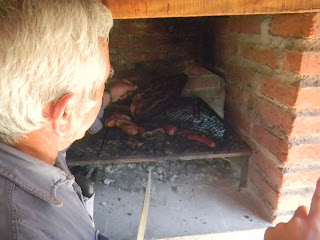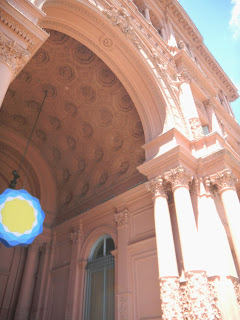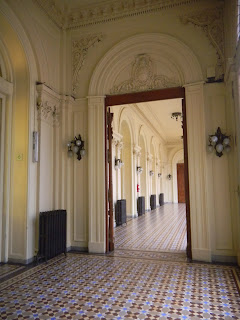So goes the slogan for
la Universidad del Salvador (USAL) - where I am taking classes this semester.
[The phrase has become a personal favorite of mine, which any of my exchange amigas can attest to.]
USAL was founded by the
Jesuits (see "The Feast Day of San Ignacio de Loyola"); is situated in downtown Buenos Aires; is a private institution; provides an education to about 20,000 students; and was the first university in Argentina to accept exchange students. But you can find all of that information through the
Northwest Missouri State University Study Abroad site.
What you won't find written in the site description is:
001. The university is split into several different facultades - colleges - and each has its own location, separate from the others.
For example, wedged here in between shops and restaurants and variegated offices is the
Facultad de Comunicación Social, where I spend my Tuesdays and Wednesdays:
 |
| Some facultades are not so clearly labeled, either. |
002. You need to know well before you book your flights which classes (or at least which types of classes) you will want to take. Prepare an expansive list. The university will ask you to fill out a sheet of 5 or 6 prospective classes; add double that number to a list of your own.
003. "Ask and it shall be given unto you."
Don't take anything for granted. The thing is, for the most part, we are taken by the hand and led through most any given process in the States, and they just don't do things that way here. Ask questions.
This rule also applies to the classroom. Whereas in the U.S., you would receive the syllabus and all required reading either in printed form or online, you have to ask for all of that here. That also includes exam dates. Ask, ask! If you aren't answered straight away, keep the aforementioned in mind. And ask again for old Liberty's sake.
004. Have patience with
los tramites.
If you're from the States, you're also used to getting things done fast. And while the city of Buenos Aires moves a lot faster than what I'm used to back in Missouri, when it comes to documentation/ registration/ (fill-in-the-blank)ation, it is much slower. A
yanqui must have patience. The thing is, it's part of the culture. Argentines are more relaxed about certain things (another example is the very European custom of taking an hour or two out of the afternoon for a
café with friends or spending hours chatting over supper; both of which are pretty well foreign to North Americans, generally speaking).
Also, when you arrive, you will receive a 30-day
travel visa. So even if you're only staying for a semester, it will just barely
not cover you. Keep in mind that you will have to make a couple visits to the Center for Migrations to obtain a
student visa.
Bottom line: patience,
yanqui-son.
P.S. - If all else fails, St. Francis de Sales.
 |
Patron Saint of patience.
Given you're in a predominantly Catholic country, it couldn't hurt to shoot him a call for help. |
005. When you start classes, it will be overwhelming at first. Depending on the
profesor, you might have to work hard just to understand, let alone to complete all the required work for the course. I would recommend a tape recorder for those instances. More than likely, however, you'll have at least one professor who is completely accommodating, responds to your emails immediately, and goes out of his/her way to ask how you're getting along. Cherish them. Use them as motivation to maintain patience with the less-helpful ones.
General tips for la gran Buenos Aires...
006. The city is huge and full of life 25/7 - use every opportunity you can to take advantage of it! There are countless museums to meander in, plazas to drink
mate at, and little tucked-in restaurants to try around every corner. Not to mention
los boliches (night clubs).
Boliches are an essential part of the Buenos Aires experience; as a college student, it's considered essential. But be prepared; going out here is quite a bit different from going out at home. You might go to a
previa (pre-game), stay there until about 1 AM, leave for the club, and stay out until 7 AM. (Girls, I would recommend you pack flats). Also, when you go out, you should always arrive
and leave with a group. That is Rule #1. When you leave, you will probably take a taxi to get home - which leads to my next point...
007. Only take taxis with a "Radio Taxi" sign on the roof. These are the registered taxis and are the reliable ones (though you should always check to make sure you aren't short-changed when getting out). Which reminds me...
008. To make sure your money is not counterfeit, the test is the same for
pesos as it is for American dollars: hold the bill up to the light and look for the watermark in the form of the person depicted on the bill.
There are a thousand other tips I could list here, but I'll stop with these for now (and maybe add another tip-filled post later).
Hasta la próxima -










































